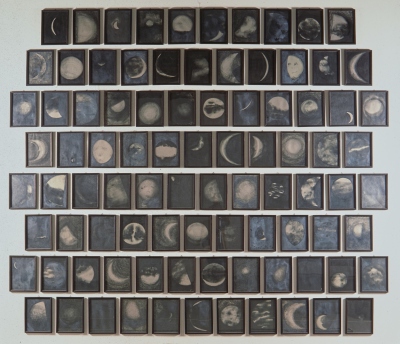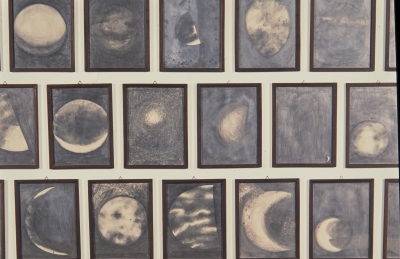Hanna Łuczak
90 x 90 Faces of the Moon
The work by Hanna Łuczak consists of 90 black and white drawings of the same size (slightly larger than A4), made on photosensitive paper and framed, and a steel gutter. Drawings show fragments of the night sky with the moon, captured differently each time, and are the carriers of poetic content and connotations. The line runs freely, the artist uses various drawing techniques, such as shading, washing, sharp contours, etc. The work refers to the space of free associations and intuition, emphasizing the phenomenon of changeability and transformation associated with the moon. This variability is also inherent in the technique: a drawing on photosensitive paper keeps working to change the subtly sketched faces of the moon. The installation is presented in the form of wallpaper, with drawings densely arranged on the wall and accompanied by a gutter filled with water on the floor along the wall. The reflections of the mysterious silver globe appear on the water, which is not subject to earthly measures and systems
Hanna Łuczak (b. 1959) is an intermedia artist who works with installation, sculpture, painting, and drawing. Her art is based upon conceptual reflection; already during her studies, she showed an analytical approach to the medium of painting. In 1982, she attempted to answer the question of what a painting is as an object – when can we talk about the canvas as a painting, when does it cease to be an object and when does it become an artistic fact. At the same time, in the years 1981—1984 Łuczak explored the possibilities of painterly language in her Painting series. At that time, she developed a formula for a layered painting, images painted on top of each other. The artist covered the surface of the canvas with any number of layers of paint, covering and destroying each previous image with the next one.
From the very beginning, Łuczak’s paintings were accompanied by drawing, which was for her an equally important means of artistic expression. Initially, she recorded successive layered images in the form of drawings and the imageries encoded in them, revealing what was covered by subsequent layers of paint. The drawings were a kind of reconstruction of the true or fictional history of the paintings, and complimented them. Later, drawing became the centre of the artist’s creative imagination, although it clearly emphasizes the fluidity and arbitrariness of the boundaries between artistic disciplines. In Łuczak’s work, drawing became an autonomous technique, unlimited by the size of a sheet of paper – she created works with an extensive conceptual narrative structure playing out in a space understood as sculptural. Drawings bound by a frame and monumental drawings created directly on the walls were entangled in relationships with objects placed in the gallery, creating coherent, multifaceted compositions.

